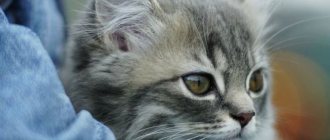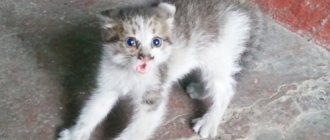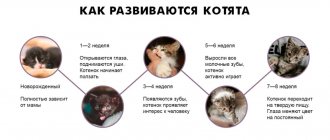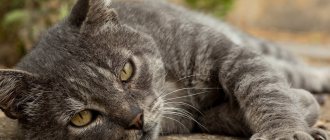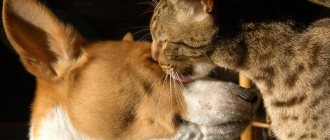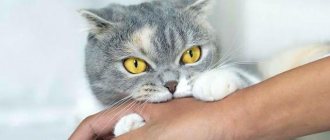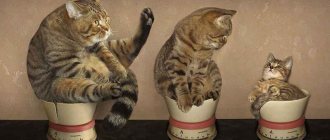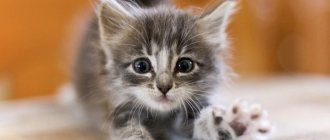If a foundling appears in the house, then the question of how to determine the age of the kitten will certainly arise. It is best to contact a specialist at a veterinary clinic. This, first of all, needs to be done in order to exclude possible diseases of the baby, and also to receive advice on maintenance and care. And, of course, the veterinarian will be able to accurately determine the age and gender of the pet.
If a foundling appears in the house, then the question of how to determine the age of the kitten will certainly arise.
It’s another matter if a visit to a specialist is impossible for some reason. You can try to determine the baby’s age yourself at home. There are a number of criteria for this.
It is immediately necessary to clarify that a kitten is considered an animal under the age of 6 months. It is during this period that age-related characteristics are clearly expressed, and even a non-specialist can analyze them. The age of a teenager or young pet can only be determined by a veterinarian.
It is necessary to clarify that a kitten is considered an animal under the age of 6 months.
We carry out an external inspection
You can estimate the age of the found kitten by its appearance and behavioral characteristics. The first thing that may catch your eye is the presence of a remaining umbilical cord. The cat itself gnaws the newborn's umbilical cord, but a small appendage remains on the tummy. The remainder of the umbilical cord falls off only after a few days, and if it is present, then the baby is most likely not even a week old.
The fact that the newborn is not even 7 days old is indicated by the baby’s closed eyes and ears. Kittens are born completely blind, and their eyes are closed until 7-10 days. They then begin to open and the kitten begins to see and respond to light. If the baby's eyes are already open, but narrow, then he is approximately 10-14 days old.
A baby's ears can also tell his age . Kittens are born with closed ear canals. The newborn's ears are tightly pressed, he does not hear and, accordingly, does not react to sounds. By the age of one week, the ears begin to rise, opening the auditory canals. Thanks to this, the kitten begins to hear. Raised, but not fully raised, ears will indicate that the pet is no more than 10 days old. At 2-3 weeks, the ears should be completely straightened, and the kitten should respond to sounds and turn its head towards their source.
You can estimate the age of a found kitten by its appearance and behavioral characteristics.
Until the eyes and ears open, the kitten leads an inactive lifestyle. All his life activity comes down to the “eat and sleep” pattern. As soon as the eyes and ears open, the baby begins to be active, tries to look around, listens, and crawls. By the age of 3 weeks, the kitten makes tentative attempts to stand and walk. This is a very funny period when a pet that can barely stand on its feet, staggering and falling, begins to show its desire to run and play.
At the age of 1 month, kittens move almost confidently and begin to “fight” obstacles. If your foundling calmly climbs out of the box at 2 times his height, then he is about 5 weeks old. At this age, he spends a lot of time awake, exploring the world around him, playing with everything that comes his way.
At the age of 1.5-2 months, noticeable changes in the kitten’s body begin. Before this, the baby’s body looks funny, but inharmonious: too large a head, small ears, short legs. After feeding, he looks more like a pear than a graceful descendant of a wild cat.
Gradually, by 2 months, everything changes: the kitten grows and the head no longer seems so big, the ears rise and lengthen, the paws stretch and become stronger, the muscles become stronger and relief appears. By the age of 3-4 months, the kitten already resembles the proportions of an adult animal, only in miniature.
A kitten's weight can also help determine its age. Usually, at birth, kittens weigh about 100 g. Then a healthy pet gains an average of 10-20 g per day. That is, on average, a one-month-old kitten will weigh about 500-600 g, and a two-month-old kitten will weigh a little more than 1 kg. If this figure fluctuates around 3 kg, it means the pet is at least 6 months old. The pet will reach the weight of an almost adult animal by 7-8 months.
Determination by size and weight can only be considered as additional criteria for assessing the age of a pet, since they largely depend on how the baby has been eating all this time.
There have been cases where volunteers have rescued kittens weighing as much as one-month-old babies. The appearance was also consistent: small body, huge head, short legs. However, based on their teeth, doctors determined that their age was much ahead of their physical condition. Poor nutrition and exhaustion took their toll. Most likely, the appearance in such a situation is the result of growing pains or rickets.
Photo of Maine Coon per year (12 months)
A 1-year-old Maine Coon cat weighs about 4.5 - 6.8 kg, and a 1-year-old Maine Coon cat weighs approximately 5.7 - 9.0 kg.
VN:F [1.9.22_1171]
wait a second...
Rating: 0.0/ 10 (0 votes cast)
Look your pet in the eyes
Eye color can be a good criterion for assessing the age of a kitten. All babies are born with blue or gray-blue eyes, but over time they change, and the pet begins to show its true “adult” eye color. If a kitten has heavenly colored eyes without any impurities, then he is no more than 2 weeks old.
By about 3-4 weeks, you can notice how a change in pigmentation begins to occur in your pet’s blue eyes. At 1.5-2 months, you can already guess from the kitten’s eyes what shade they will ultimately be, but the color is not yet completely clear and bright. Usually they say - with blueness. Fully “adult” eye color can be seen by 2.5-3 months.
If a small-looking kitten is adopted into a home, for example, with bright green eyes, then it is at least 3 months old.
This method is not suitable if nature gave your pet blue eyes. For example, if we are talking about the Angora or Thai breed. There will be no change in pigmentation due to age. We need to look for another way.
Maine Coon kittens 1 month
The weight of a Maine Coon cat at 1 month is approximately 560 - 740 grams, and a 1 month old Maine Coon cat weighs about 630 - 820 grams.
Red kitten, 1 month
Tortoiseshell
Black marble
Looking a gift cat in the mouth?
The most accurate way to determine a kitten's age is by its teeth. They are absent for up to 10 days, but within just a few days the front incisors begin to quickly appear. Usually, by the third week, a row of 6 primary incisors is ready on each pet's jaw. Around the same time, fangs appear.
Primary canines should finally erupt at the age of 1.5 months. These are long, sharp teeth that are located on the sides of the front incisors. Then small molars grow - premolars. As a result, the kitten should have 3 milk teeth on each side on the upper jaw and 2 on the lower jaw. The process of the appearance of baby teeth ends completely by 2 months.
Have you brought home a kitten, but don’t know how old it is? Start counting your teeth. If 26 of them are found in the oral cavity, then the foundling is at least 2 months old. However, there may be more teeth. Then the kitten is about 4 months old, and the “extra” teeth are molars, or molars. If milk teeth become mobile or fall out, then the replacement of milk teeth has begun. This means the pet is about 5 months old. This usually ends in teenage kittens at 6 months of age.
You need to know the age of the kitten literally up to a week, as this is important for choosing the right food option and caring for your pet. Therefore, you need to carefully study all the above criteria and compare them with the characteristics of the pet. The more matches are found, the more accurate the result will be.
Maine Coon 7 months
The weight of a Maine Coon cat at 7 months is from 3.500 to 4.900, and the weight of a Maine Coon cat at 7 months is from 4.200 to 6.500 kg
How to feed a kitten from birth to one year
When puppies open their eyes after birth
Feeding kittens plays a vital role in their development. Their health depends on it. In the first three days after birth, babies feed on maternal colostrum, then from the 3rd day of life until 2-2.5 months - breast milk.
At 4–5 months, babies are fed five times a day
Complementary foods should be introduced closer to 1 month. It is best to give babies special food for kittens. It is advisable to choose premium and super-premium food or food from the holistic group. Children's meat pates, cottage cheese, and lean boiled meat, which needs to be finely chopped, are well suited as first complementary foods. At 5 weeks, a kitten needs 100–150 g of food per day.
Two-month-old kittens should be given 2-3 pouches per day, as well as a bowl of dry food. They should have six meals a day; if necessary, the frequency of feeding is increased to 7 times a day.
Important! The kitten must drink fresh, clean water, so you need to place a drinking cup next to the bowl.
At 8 months, cats can be sterilized
You need to know well what to feed a 3-month-old kitten: homemade food should be carefully selected. You cannot feed animals regular food from the human table. From natural products, finely chopped boiled turkey, chicken, and beef are suitable.
You should not give your kids fatty meats, pork, lard, or smoked meats. In addition, the diet should not consist only of meat. Kittens need to be offered porridge: buckwheat, semolina, rice, as well as boiled vegetables: carrots, broccoli, zucchini, beets, cabbage. Small cats love low-fat or low-fat dairy products: cottage cheese, sour cream, cream, fermented baked milk. Once a week you can give your kids a boiled egg or some lean boiled fish: cod, haddock, hake.
Having remembered what to feed a three-month-old kitten, you need to learn the list of prohibited foods:
- cow's milk;
- fish and meat with bones;
- smoked, salted, fried foods;
- sweets, baked goods;
- grapes, raisins, potatoes, legumes;
- food from the table.
When choosing what to feed a 3-month-old kitten, you need to decide on the type of diet: natural food or special food. To do this, you need to contact a veterinarian.
It is best to feed kittens wet food in pouches. An additional recipe is known: dry food is poured with boiled water.
The health of the kitten and its entire future life depend on proper nutrition.
Kittens under 3 months old should not be separated from their mother.
Watching kittens grow is very pleasant and joyful. But this is also a very responsible activity, because it will help keep the kids healthy.
